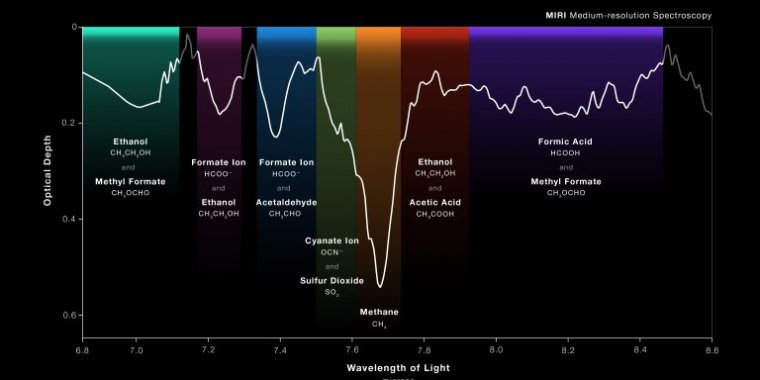| News / Space News |
NASA’s Webb Finds Ethanol, Other Icy Ingredients for Worlds
An international team of astronomers used Webb’s MIRI (Mid-Infrared Instrument) to identify a variety of icy compounds made up of complex organic molecules like ethanol (alcohol) and likely acetic acid (an ingredient in vinegar).

NASA’s James Webb Space Telescope’s MIRI (Mid-Infrared Instrument) has identified a variety of complex organic molecules that are present in interstellar ices surrounding two protostars. These molecules, which are key ingredients for making potentially habitable worlds, include ethanol, formic acid, methane, and likely acetic acid, in the solid phase. The finding came from the study of two protostars, IRAS 2A and IRAS 23385, both of which are so young that they are not yet forming planets. Photo: NASA, ESA, CSA, L. Hustak (STScI). Science: W. Rocha (Leiden University).
“This finding contributes to one of the long-standing questions in astrochemistry,” said team leader Will Rocha of Leiden University in the Netherlands.
“What is the origin of complex organic molecules, or COMs, in space? Are they made in the gas phase or in ices? The detection of COMs in ices suggests that solid-phase chemical reactions on the surfaces of cold dust grains can build complex kinds of molecules.”
As several COMs, including those detected in the solid phase in this research, were previously detected in the warm gas phase, it is now believed that they originate from the sublimation of ices.
Sublimation is to change directly from a solid to a gas without becoming a liquid. Therefore, detecting COMs in ices makes astronomers hopeful about improved understanding of the origins of other, even larger molecules in space.
Scientists are also keen to explore to what extent these COMs are transported to planets at much later stages of protostellar evolution.
COMs in cold ices are thought to be easier to transport from molecular clouds to planet-forming disks than warm, gaseous molecules.
These icy COMs can therefore be incorporated into comets and asteroids, which in turn may collide with forming planets, delivering the ingredients for life to possibly flourish.
The science team also detected simpler molecules, including formic acid (which causes the burning sensation of an ant sting), methane, formaldehyde, and sulfur dioxide.
Research suggests that sulfur-containing compounds like sulfur dioxide played an important role in driving metabolic reactions on the primitive Earth.
Of particular interest is that one of the sources investigated, IRAS 2A, is characterized as a low-mass protostar. IRAS 2A may therefore be similar to the early stages of our own solar system.
As such, the chemicals identified around this protostar may have been in the first stages of development of our solar system and later delivered to the primitive Earth.
“All of these molecules can become part of comets and asteroids and eventually new planetary systems when the icy material is transported inward to the planet-forming disk as the protostellar system evolves,” said Ewine van Dishoeck of Leiden University, one of the coordinators of the science program.
“We look forward to following this astrochemical trail step-by-step with more Webb data in the coming years.”
YOU MAY ALSO LIKE





